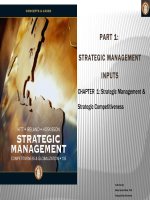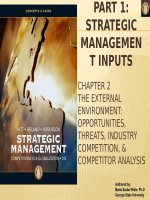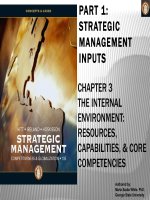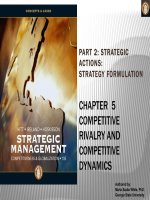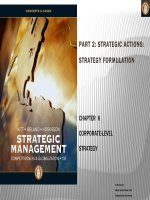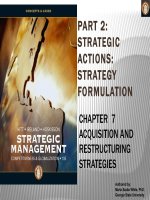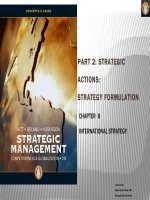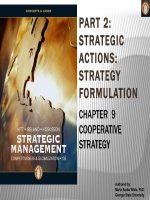Chapter 3 strategic management competitiveness and globalization 10e
Bạn đang xem bản rút gọn của tài liệu. Xem và tải ngay bản đầy đủ của tài liệu tại đây (927.61 KB, 50 trang )
PART 1:
STRATEGIC
MANAGEMENT
INPUTS
CHAPTER 3
THE INTERNAL
ENVIRONMENT:
RESOURCES,
CAPABILITIES, & CORE
COMPETENCIES
Authored by:
Marta Szabo White. PhD.
Georgia State University
THE STRATEGIC MANAGEMENT
PROCESS
©2013 Cengage Learning. All Rights Reserved. May not be copied, scanned, or duplicated, in whole or in part, except for use as
permitted in a license distributed with a certain product or service or otherwise on a password-protected website for classroom use.
KNOWLEDGE OBJECTIVES
● Explain why firms need to study and understand their
internal organization.
● Define value and discuss its importance.
● Describe the differences between tangible and
intangible resources.
● Define capabilities and discuss their development.
● Describe four criteria used to determine whether
resources and capabilities are core competencies.
©2013 Cengage Learning. All Rights Reserved. May not be copied, scanned, or duplicated, in whole or in part, except for use as
permitted in a license distributed with a certain product or service or otherwise on a password-protected website for classroom use.
KNOWLEDGE OBJECTIVES
● Explain how firms analyze their value chain for the
purpose of determining where they are able to create
value when using their resources, capabilities, and
core competencies.
● Define outsourcing and discuss reasons for its use.
● Discuss the importance of identifying internal
strengths and weaknesses.
● Discuss the importance of avoiding core rigidities.
©2013 Cengage Learning. All Rights Reserved. May not be copied, scanned, or duplicated, in whole or in part, except for use as
permitted in a license distributed with a certain product or service or otherwise on a password-protected website for classroom use.
OPENING CASE
SUBWAY RESTAURANTS:
CORE COMPETENCIES AS THE FOUNDATION FOR SUCCESS
• 1965: Subway opened its first shop
• Current portfolio of almost 35,000 units located in
98 countries
• More store locations than McDonald’s
• Subway’s focus on “Eat Fresh,” high-quality foods,
continuous training, customer service, and “nontraditional” store locations illustrate Subway’s core
competencies and the foundation for competitive
advantage, underscoring key chapter concepts
©2013 Cengage Learning. All Rights Reserved. May not be copied, scanned, or duplicated, in whole or in part, except for use as
permitted in a license distributed with a certain product or service or otherwise on a password-protected website for classroom use.
EXTERNAL ANALYSES’
OUTCOMES
Opportunities
and Threats
By studying the external environment,
firms identify what they MIGHT CHOOSE
TO DO
©2013 Cengage Learning. All Rights Reserved. May not be copied, scanned, or duplicated, in whole or in part, except for use as
permitted in a license distributed with a certain product or service or otherwise on a password-protected website for classroom use.
INTERNAL ANALYSES’
OUTCOMES
Unique
Resources,
Capabilities, and
Competencies
(required for
sustainable
competitive
advantage)
By studying the internal environment, firms
identify what they CAN DO
©2013 Cengage Learning. All Rights Reserved. May not be copied, scanned, or duplicated, in whole or in part, except for use as
permitted in a license distributed with a certain product or service or otherwise on a password-protected website for classroom use.
STRATEGIC COMPETITIVENESS AND
ABOVE- AVERAGE RETURNS RESULT
WHEN:
INTERNAL
ORGANIZATI
ON
•What a firm can do:
EXTERNAL
ENVIRONME
NT
What a firm might
do:
• Function of resources,
capabilities, and core
competencies
MATCH
ES •
• Function of opportunities in
the firm’s external
environment
©2013 Cengage Learning. All Rights Reserved. May not be copied, scanned, or duplicated, in whole or in part, except for use as
permitted in a license distributed with a certain product or service or otherwise on a password-protected website for classroom use.
COMPETITIVE ADVANTAGE
KEY POINTS
■ No competitive advantage lasts forever
■ Over time, rivals use their own unique
resources, capabilities, and core
competencies to duplicate the focal firm’s
ability to create value for customers
■ With globalization, sustainable
competitive advantage is especially
challenging
©2013 Cengage Learning. All Rights Reserved. May not be copied, scanned, or duplicated, in whole or in part, except for use as
permitted in a license distributed with a certain product or service or otherwise on a password-protected website for classroom use.
COMPETITIVE ADVANTAGE
KEY POINTS
■ Firms must exploit their current
advantages while simultaneously using
their resources and capabilities to form
new advantages that can lead to future
competitive success
■ INNOVATION and PEOPLE are critical
resources for organizations in their
quest for competitive advantage
©2013 Cengage Learning. All Rights Reserved. May not be copied, scanned, or duplicated, in whole or in part, except for use as
permitted in a license distributed with a certain product or service or otherwise on a password-protected website for classroom use.
COMPETITIVE ADVANTAGE
SUSTAINABILIT Y
Sustainability of a competitive
advantage is a function of:
• The rate of core competence obsolescence
due to environmental changes
• The availability of substitutes for the core
competence
• The imitability of the core competence
©2013 Cengage Learning. All Rights Reserved. May not be copied, scanned, or duplicated, in whole or in part, except for use as
permitted in a license distributed with a certain product or service or otherwise on a password-protected website for classroom use.
ANALYZING THE INTERNAL
ORGANIZATION
The Context of Internal Analysis
Global Economy
Traditional sources of advantages can be overcome by
competitors’ international strategies and by the flow of
resources throughout the global economy
Global Mindset
The ability to study an internal environment in ways that are
not dependent on the assumptions of a single country, culture,
or context
Analysis Outcome
Understanding how to leverage the firm’s bundle of
heterogeneous resources and capabilities
©2013 Cengage Learning. All Rights Reserved. May not be copied, scanned, or duplicated, in whole or in part, except for use as
permitted in a license distributed with a certain product or service or otherwise on a password-protected website for classroom use.
COMPETITIVE ADVANTAGE
FIGURE 3.1
Components of Internal Analysis Leading to Competitive
Advantage and Strategic Competitiveness
Components of
an Internal
Analysis
©2013 Cengage Learning. All Rights Reserved. May not be copied, scanned, or duplicated, in whole or in part, except for use as
permitted in a license distributed with a certain product or service or otherwise on a password-protected website for classroom use.
ANALYZING THE INTERNAL
ORGANIZATION
Creating Value
By innovatively bundling and leveraging their resources and
capabilities; by exploiting their core competencies or
competitive advantages, firms create value.
Value is measured by:
• Product performance characteristics
• Product attributes for which customers are willing to pay
Superior value Above-average returns
©2013 Cengage Learning. All Rights Reserved. May not be copied, scanned, or duplicated, in whole or in part, except for use as
permitted in a license distributed with a certain product or service or otherwise on a password-protected website for classroom use.
ANALYZING THE INTERNAL
ORGANIZATION
The Challenge of Analyzing
the Internal Organization
Strategic decisions
● Are non-routine
● Have ethical implications
● Significantly influence the firm’s ability to
earn above-average returns
Strategic leaders make effective decisions
regarding the firm’s resources, capabilities, and
core competencies and decide on their use
©2013 Cengage Learning. All Rights Reserved. May not be copied, scanned, or duplicated, in whole or in part, except for use as
permitted in a license distributed with a certain product or service or otherwise on a password-protected website for classroom use.
ANALYZING THE INTERNAL
ORGANIZATION
The Challenge of Analyzing
the Internal Organization
Managers face uncertainty on many fronts
● Proprietary technologies
● Changes in economic and political trends,
societal values and shifts in customer
demands
● Environment – increasing complexity
Intraorganizational conflict
● Results from decisions about core
competencies and how to develop them
©2013 Cengage Learning. All Rights Reserved. May not be copied, scanned, or duplicated, in whole or in part, except for use as
permitted in a license distributed with a certain product or service or otherwise on a password-protected website for classroom use.
FIGURE 3.2
ANALYZING THE INTERNAL
ORGANIZATION
Conditions
Affecting
Managerial
Decisions
About
Resources,
Capabilities,
and Core
Competences
©2013 Cengage Learning. All Rights Reserved. May not be copied, scanned, or duplicated, in whole or in part, except for use as
permitted in a license distributed with a certain product or service or otherwise on a password-protected website for classroom use.
ANALYZING THE INTERNAL
ORGANIZATION
The Challenge of Analyzing
the Internal Organization
Learning
● Generated by making and correcting
mistakes; can be important in creating new
capabilities and core competencies
Judgment is required under these
conditions
● Decision makers often take intelligent risks
● With good judgment, successful strategic
leaders achieve strategic competitiveness
©2013 Cengage Learning. All Rights Reserved. May not be copied, scanned, or duplicated, in whole or in part, except for use as
permitted in a license distributed with a certain product or service or otherwise on a password-protected website for classroom use.
RESOURCES, CAPABILITIES,
AND CORE COMPETENCIES
Core
Competencies
Resources and superior
capabilities that are sources of
competitive advantage over a
firm’s rivals
Capabilities
An integrated and coordinated
set of actions taken to exploit
core competencies and gain
competitive advantage
Resources
•Tangible
•Intangible
Providing value to customers
and gaining competitive
advantage by exploiting core
competencies in individual
product markets
©2013 Cengage Learning. All Rights Reserved. May not be copied, scanned, or duplicated, in whole or in part, except for use as
permitted in a license distributed with a certain product or service or otherwise on a password-protected website for classroom use.
RESOURCES, CAPABILITIES,
AND CORE COMPETENCIES
Core
Competenci
es
RESOURCES
•
•
•
•
Capabilities
•
Are the source of a firm’s capabilities
Are broad in scope
Cover a spectrum of individual, social, and
organizational phenomena
Represent inputs into a firm’s production
process
Alone, do not yield a competitive advantage,
i.e., by themselves do not allow firms to create
value that results in above-average returns
Resources
•Tangibl
e
•Intangib
le
©2013 Cengage Learning. All Rights Reserved. May not be copied, scanned, or duplicated, in whole or in part, except for use as
permitted in a license distributed with a certain product or service or otherwise on a password-protected website for classroom use.
RESOURCES, CAPABILITIES,
AND CORE COMPETENCIES
T YPES OF RESOURCES
Tangible Resources
• Assets
that can be seen, touched, and
quantified
Intangible Resources
• Assets
rooted deeply in the firm’s history,
accumulated over time
• In comparison
to ‘tangible’
resources,
Compared
to tangible
resources,
intangible
resources
arebea seen
superior
source of core
usually can’t
or touched
competencies
©2013 Cengage Learning. All Rights Reserved. May not be copied, scanned, or duplicated, in whole or in part, except for use as
permitted in a license distributed with a certain product or service or otherwise on a password-protected website for classroom use.
RESOURCES, CAPABILITIES
AND, CORE COMPETENCIES
T YPES OF RESOURCES
Tangible Resources
•
FINANCIAL RESOURCES - the firm’s capacity to borrow and
generate internal funds
•
ORGANIZATIONAL RESOURCES - formal reporting structures
•
PHYSICAL RESOURCES - sophistication and location of a firm’s
plant and equipment; distribution facilities; product inventory
•
TECHNOLOGICAL RESOURCES - stock of technology, such as
patents, trademarks, copyrights, and trade secrets
©2013 Cengage Learning. All Rights Reserved. May not be copied, scanned, or duplicated, in whole or in part, except for use as
permitted in a license distributed with a certain product or service or otherwise on a password-protected website for classroom use.
RESOURCES, CAPABILITIES
AND, CORE COMPETENCIES
T YPES OF RESOURCES
Intangible Resources
•
HUMAN RESOURCES - knowledge; trust;
skills; collaborative abilities
•
INNOVATION RESOURCES - scientific
capabilities; capacity to innovate
•
REPUTATIONAL RESOURCES - brand name;
perceptions of product quality, durability, and
reliability; positive reputation with
stakeholders, e.g., suppliers/customers
©2013 Cengage Learning. All Rights Reserved. May not be copied, scanned, or duplicated, in whole or in part, except for use as
permitted in a license distributed with a certain product or service or otherwise on a password-protected website for classroom use.
RESOURCES, CAPABILITIES,
AND CORE COMPETENCIES
Core
Competenci
es
Capabilities
CAPABILITIES
■ Emerge over time through complex interactions
among tangible and intangible resources
■ Stem from employees
• Unique skills and knowledge
• Functional expertise
■ Are activities that a firm performs exceptionally
well relative to rivals
■ Are activities through which the firm adds
unique value to its goods or services over an
extended period of time
Resources
•Tangibl
e
•Intangib
le
©2013 Cengage Learning. All Rights Reserved. May not be copied, scanned, or duplicated, in whole or in part, except for use as
permitted in a license distributed with a certain product or service or otherwise on a password-protected website for classroom use.
RESOURCES, CAPABILITIES,
AND CORE COMPETENCIES
Core
Competenci
es
Capabilities
CAPABILITIES (cont’d)
■ Exist when resources have been purposely
integrated to achieve a specific task or set of
tasks
■ Are often developed in specific functional areas
• Distribution
• Human resources
• Management information systems
• Marketing
• Management
• Manufacturing
• Research & Development
Resources
•Tangibl
e
•Intangib
le
©2013 Cengage Learning. All Rights Reserved. May not be copied, scanned, or duplicated, in whole or in part, except for use as
permitted in a license distributed with a certain product or service or otherwise on a password-protected website for classroom use.
